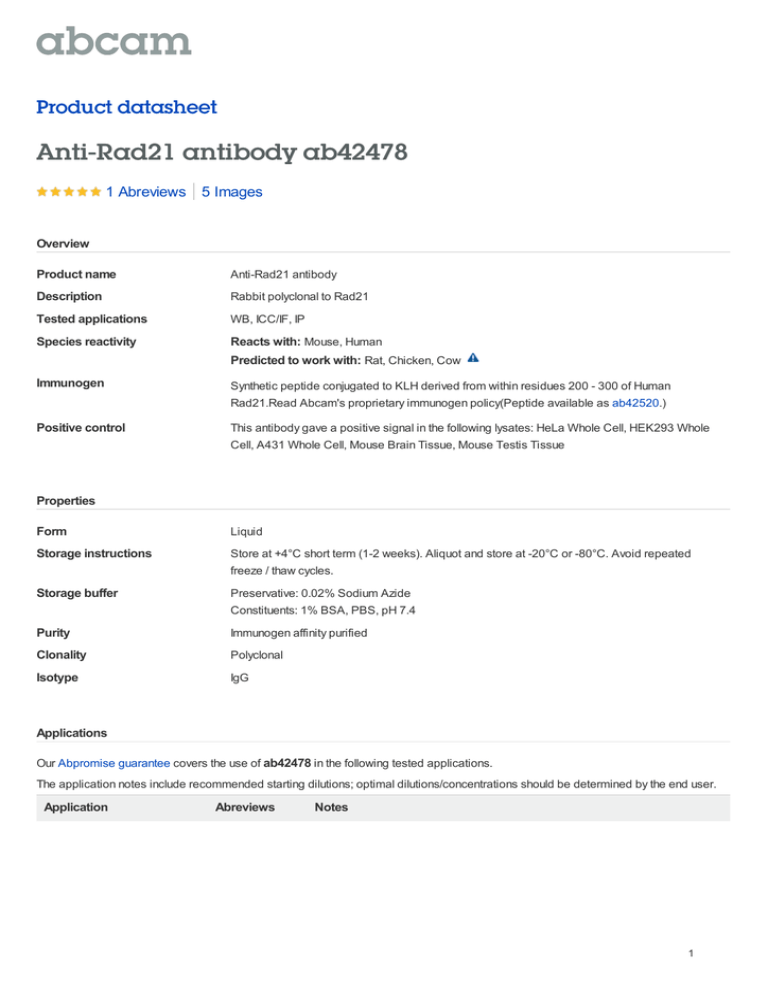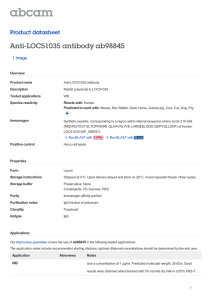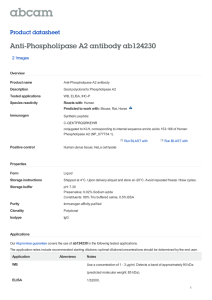Anti-Rad21 antibody ab42478 Product datasheet 1 Abreviews 5 Images
advertisement

Product datasheet Anti-Rad21 antibody ab42478 1 Abreviews 5 Images Overview Product name Anti-Rad21 antibody Description Rabbit polyclonal to Rad21 Tested applications WB, ICC/IF, IP Species reactivity Reacts with: Mouse, Human Predicted to work with: Rat, Chicken, Cow Immunogen Synthetic peptide conjugated to KLH derived from within residues 200 - 300 of Human Rad21.Read Abcam's proprietary immunogen policy(Peptide available as ab42520.) Positive control This antibody gave a positive signal in the following lysates: HeLa Whole Cell, HEK293 Whole Cell, A431 Whole Cell, Mouse Brain Tissue, Mouse Testis Tissue Properties Form Liquid Storage instructions Store at +4°C short term (1-2 weeks). Aliquot and store at -20°C or -80°C. Avoid repeated freeze / thaw cycles. Storage buffer Preservative: 0.02% Sodium Azide Constituents: 1% BSA, PBS, pH 7.4 Purity Immunogen affinity purified Clonality Polyclonal Isotype IgG Applications Our Abpromise guarantee covers the use of ab42478 in the following tested applications. The application notes include recommended starting dilutions; optimal dilutions/concentrations should be determined by the end user. Application Abreviews Notes 1 Application WB Abreviews Notes Use a concentration of 1 µg/ml. Detects a band of approximately 100 kDa (predicted molecular weight: 75 kDa). Although the predicted band size is 75kDa based on Swiss-prot data, a band of 120kDa has been previously observed. Mol Cell Biol. 2002 Dec;22(23):8267-77 PMID: 12417729. The band seen at 100kDa is also consistent with the banding pattern observed for other commercially available antibodies to Rad21. ICC/IF Use a concentration of 1 µg/ml. IP Use at an assay dependent concentration. Target Function Cleavable component of the cohesin complex, involved in chromosome cohesion during cell cycle, in DNA repair, and in apoptosis. The cohesin complex is required for the cohesion of sister chromatids after DNA replication. The cohesin complex apparently forms a large proteinaceous ring within which sister chromatids can be trapped. At metaphase-anaphase transition, this protein is cleaved by separase/ESPL1 and dissociates from chromatin, allowing sister chromatids to segregate. The cohesin complex may also play a role in spindle pole assembly during mitosis. Also plays a role in apoptosis, via its cleavage by caspase-3/CASP3 or caspase-7/CASP7 during early steps of apoptosis: the C-terminal 64 kDa cleavage product may act as a nuclear signal to initiate cytoplasmic events involved in the apoptotic pathway. Sequence similarities Belongs to the rad21 family. Domain The C-terminal part associates with the head of SMC1A, while the N-terminal part binds to the head of SMC3. Post-translational modifications Cleaved by separase/ESPL1 at the onset of anaphase. Cleaved by caspase-3 and caspase-7 at the beginning of apoptosis. The cleavage by ESPL1 and caspase-3 take place at different sites. Phosphorylated; becomes hyperphosphorylated in M phase of cell cycle. The large dissociation of cohesin from chromosome arms during prophase may be partly due to its phosphorylation by PLK. Cellular localization Nucleus. Chromosome. Chromosome > centromere. Associates with chromatin. Before prophase it is scattered along chromosome arms. During prophase, most of cohesin complexes dissociate from chromatin probably because of phosphorylation by PLK, except at centromeres, where cohesin complexes remain. At anaphase, it is cleaved by separase/ESPL1, leading to the dissociation of the complex from chromosomes, allowing chromosome separation. Once cleaved by caspase-3, the C-terminal 64 kDa cleavage product translocates to the cytoplasm, where it may trigger apoptosis. Anti-Rad21 antibody images 2 ab42478 (1/200) staining Rad21 in assynchronous HeLa cells (green). Cells were fixed in paraformaldehyde, permeabilized with 0.5% Triton X-100 and counterstained with DAPI in order to highlight the nucleus Immunocytochemistry/ Immunofluorescence - (red). for further experimental details please Rad21 antibody (ab42478) see Abreview. Image courtesy of an Abreview submitted by Dr. Kirk McManus, Univ. of Manitoba/Cancer Care MICB, Canada All lanes : Anti-Rad21 antibody (ab42478) at 1 µg/ml Lane 1 : HeLa (Human epithelial carcinoma cell line) Whole Cell Lysate Lane 2 : HEK293 Human embryonic kidney cell line Whole Cell Lysate Lane 3 : A431 (Human epithelial carcinoma cell line) Whole Cell Lysate Lysates/proteins at 10 µg per lane. Western blot - Rad21 antibody (ab42478) Secondary IRDye 680 Conjugated Goat Anti-Rabbit IgG (H+L) at 1/10000 dilution Performed under reducing conditions. Predicted band size : 75 kDa Observed band size : 100 kDa Additional bands at : 55 kDa (possible cleavage fragment). 3 All lanes : Anti-Rad21 antibody (ab42478) at 1 µg/ml Lane 1 : Brain (Mouse) Tissue Lysate Lane 2 : Testis (Mouse) Tissue Lysate Lysates/proteins at 10 µg per lane. Secondary Goat polyclonal to Rabbit IgG - H&L - PreAdsorbed (HRP) at 1/3000 dilution Western blot - Rad21 antibody (ab42478) developed using the ECL technique Performed under reducing conditions. Predicted band size : 75 kDa Observed band size : 120 kDa Additional bands at : 55 kDa,85 kDa. We are unsure as to the identity of these extra bands. Exposure time : 4 minutes 4 Rad21 was immunoprecipitated using 0.5mg Hela whole cell extract, 5µg of Rabbit polyclonal to Rad21 and 50µl of protein G magnetic beads (+). No antibody was added to the control (-). The antibody was incubated under agitation with Protein G beads for 10min, Hela whole cell extract lysate diluted in RIPA buffer was added to each sample and incubated for a further 10min under agitation. Proteins were eluted by addition of 40µl SDS Immunoprecipitation - Anti-Rad21 antibody loading buffer and incubated for 10min at (ab42478) 70oC; 10µl of each sample was separated on a SDS PAGE gel, transferred to a nitrocellulose membrane, blocked with 5% BSA and probed with ab42478. Secondary: Goat polyclonal to mouse IgG light chain specific (HRP) at 1/5000 dilution. Band: 100kDa: Rad21; Non specific - 50kDa: We are unsure as to the identity of this extra band. Although the predicted band size is 75kDa based on Swiss-prot data, a band of 120kDa has been previously observed. Mol Cell Biol. 2002 Dec;22(23):8267-77 PMID: 12417729. The band seen at 100kDa is also consistent with the banding pattern observed for other commercially available antibodies to Rad21. ICC/IF image of ab42478 stained human HeLa cells. The cells were PFA fixed (10 min), permabilised in TBS-T (20 min) and incubated with the antibody (ab42478, 1µg/ml) for 1h at room temperature. 1%BSA / 10% normal goat serum / 0.3M glycine was used to quench autofluorescence and block non-specific protein-protein interactions. The Immunocytochemistry/ Immunofluorescence - secondary antibody (green) was Alexa Fluor® Rad21 antibody (ab42478) 488 goat anti-rabbit IgG (H+L) used at a 1/1000 dilution for 1h. Alexa Fluor® 594 WGA was used to label plasma membranes (red). DAPI was used to stain the cell nuclei (blue). Please note: All products are "FOR RESEARCH USE ONLY AND ARE NOT INTENDED FOR DIAGNOSTIC OR THERAPEUTIC USE" Our Abpromise to you: Quality guaranteed and expert technical support 5 Replacement or refund for products not performing as stated on the datasheet Valid for 12 months from date of delivery Response to your inquiry within 24 hours We provide support in Chinese, English, French, German, Japanese and Spanish Extensive multi-media technical resources to help you We investigate all quality concerns to ensure our products perform to the highest standards If the product does not perform as described on this datasheet, we will offer a refund or replacement. For full details of the Abpromise, please visit http://www.abcam.com/abpromise or contact our technical team. Terms and conditions Guarantee only valid for products bought direct from Abcam or one of our authorized distributors 6

